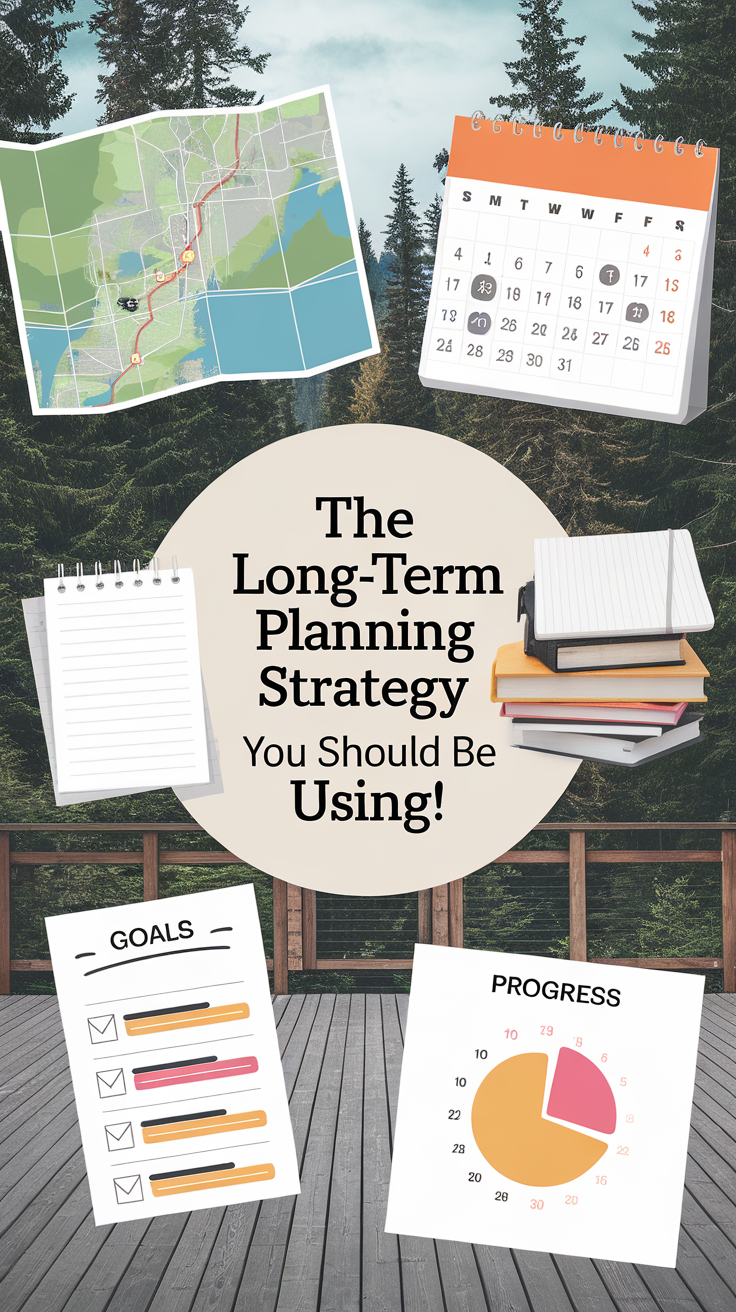The Secret to Effective Long-Term Planning Revealed!
The secret to effective long-term planning lies in setting clear goals and remaining adaptable. Start with a strong vision that outlines what you want to achieve across various aspects of your life. Break that vision into manageable milestones, making sure to track your progress regularly. Keep your timelines realistic and flexible to adapt to unexpected changes. Celebrate your achievements, no matter how small, to fuel your motivation. Consistent monitoring allows you to stay focused on your goals and adjust your strategies. Stay with us as we reveal more strategies to enhance your long-term planning game.
Understanding Long-Term Planning
Long-term planning is like navigating a ship through uncharted waters; it requires foresight and strategy to reach your destination. When you think about long-term planning, you’re not just considering immediate needs but also anticipating future challenges and opportunities. This process involves evaluating your current situation, understanding potential obstacles, and identifying resources that’ll help you along the way.
To grasp long-term planning effectively, you need to analyze trends and patterns in your life or business. Understanding these elements allows you to make informed decisions, ensuring you’re not only reacting to changes but proactively shaping your future. It’s crucial to stay adaptable, as the landscape can shift unexpectedly.
Additionally, you should prioritize your values and vision. This alignment helps keep you focused on what truly matters, guiding your choices over time. Remember, long-term planning isn’t a one-time event; it’s an ongoing process that requires regular reflection and adjustment. Embracing this mindset empowers you to steer your course with confidence, turning uncertainty into opportunity. As you enhance your understanding of long-term planning, you’ll unlock the potential to create a future that aligns with your aspirations.
Setting Clear Goals
To set clear goals, you need to start by defining your vision for the future. Once that’s in place, prioritize key objectives that align with that vision and establish measurable milestones to track your progress. This structured approach will keep you focused and motivated as you work toward your long-term aspirations.
Define Your Vision
A clear vision serves as the foundation for effective long-term planning. When you define what success looks like for you, you create a roadmap to guide your decisions and actions. Start by envisioning where you want to be in five, ten, or even twenty years. This vision should be specific, realistic, and inspiring.
Think about different aspects of your life: career, relationships, health, and personal growth. What do you want to achieve in each area? Write it down. This exercise helps clarify your priorities and keeps you focused.
Once you have your vision, break it into manageable pieces. Each piece can represent a milestone on your journey. By doing this, you not only have a clear target, but you also make the process less overwhelming.
Prioritize Key Objectives
With your vision in place, the next step is to prioritize key objectives that will help you achieve your goals. Start by identifying the most crucial areas that directly contribute to your vision. Focus on what will have the greatest impact, and don’t get sidetracked by less important tasks.
Make a list of these objectives and rank them based on urgency and importance. Remember, not everything can be a priority; choose a few key objectives that will drive your progress. This approach lets you allocate your time and resources effectively, ensuring that you’re working on what truly matters.
As you prioritize, consider the resources you have at your disposal. Are there specific skills or tools you need to reach these objectives? If so, factor those into your planning.
Finally, stay flexible. As you make progress, reassess your objectives periodically. You might discover that certain goals need more attention or new priorities have emerged. By keeping your focus on key objectives, you’ll stay aligned with your vision and maintain momentum toward your long-term success.
Establish Measurable Milestones
Setting measurable milestones is crucial for tracking your progress and keeping your objectives in sight. When you break your long-term goals into smaller, achievable milestones, you create a roadmap that guides your journey. These milestones serve as checkpoints, allowing you to evaluate your performance and make adjustments if necessary.
Start by defining clear, specific milestones related to your overall goals. For instance, if your goal is to increase sales by 20% over a year, set quarterly milestones to monitor your progress. This way, you can analyze what’s working and what isn’t, keeping you motivated along the way.
Next, make sure your milestones are measurable. Instead of saying you want to “improve customer satisfaction,” aim for a specific score on customer feedback surveys. This clarity helps you know exactly what success looks like.
Finally, celebrate each milestone you achieve. Recognizing your progress reinforces positive behavior and keeps you engaged in your long-term plan. By establishing measurable milestones, you not only track your progress but also ensure you stay focused, motivated, and on the path to achieving your ultimate goals.
Creating a Realistic Timeline
Creating a realistic timeline is crucial for ensuring your long-term planning stays on track. Without a structured timeline, you risk losing focus and motivation. Here are four steps to help you create an effective timeline:
-
Assess Your Goals: Start by clearly defining your long-term goals. What do you want to achieve?
-
Break It Down: Divide those goals into smaller, manageable tasks. This helps you see the necessary actions to get there.
-
Set Deadlines: Assign realistic deadlines to each task. Consider your personal commitments and potential obstacles that might arise.
-
Stay Flexible: Life can be unpredictable. Be prepared to adjust your timeline as needed without losing sight of your ultimate goals.
Identifying Milestones
To make your long-term plan effective, you need to identify specific milestones that mark your progress. Start by setting clear objectives that align with your goals, so you know exactly what you’re aiming for. Then, track your progress regularly to ensure you’re on the right path and adjust as needed.
Setting Clear Objectives
When embarking on a long-term planning journey, identifying milestones plays a crucial role in keeping you on track. Setting clear objectives is essential because it clarifies what you want to achieve and provides a roadmap for your efforts. Start by breaking your overarching goal into manageable parts. This way, you won’t feel overwhelmed and can celebrate small victories along the way.
To effectively set clear objectives, consider these four key steps:
-
Define Specific Goals****: Make your objectives as clear and specific as possible. Vague goals can lead to confusion.
-
Make Them Measurable: Establish criteria to measure your progress. This allows you to see how far you’ve come.
-
Set Realistic Timelines****: Assign deadlines to each milestone. This creates a sense of urgency and helps you prioritize tasks.
-
Ensure They’re Relevant: Align your objectives with your long-term vision. This keeps you motivated and focused on what truly matters.
Tracking Progress Regularly
Tracking progress regularly is vital for maintaining momentum in your long-term planning efforts. By identifying milestones, you create a roadmap that keeps you focused and motivated. Break your overarching goals into smaller, manageable steps. These milestones act as checkpoints, allowing you to assess where you are and what needs adjustment.
Start by determining key milestones related to your objectives. They can be weekly, monthly, or quarterly, depending on your timeline. Once you’ve set these markers, regularly review your progress. Ask yourself: Are you on track? What challenges have you encountered? This reflection helps you stay accountable and adapt your strategies as needed.
Celebrate your achievements, no matter how small. Recognizing these wins boosts your motivation and reinforces your commitment to your long-term goals. If you find yourself falling behind, don’t hesitate to reassess your plan. Maybe you need to adjust your milestones or allocate more resources.
Incorporating regular progress checks into your routine fosters a proactive mindset. It keeps you engaged and ensures you’re consistently moving forward. Ultimately, tracking progress isn’t just about measuring success; it’s about building a habit that leads to lasting achievement.
Tracking Progress Effectively
Effective long-term planning hinges on the ability to monitor your progress consistently. Without effective tracking, it’s easy to lose sight of your goals and drift off course. To ensure you’re making strides toward your objectives, focus on these key strategies:
-
Set Clear Milestones: Break down your long-term goals into smaller, manageable milestones. This way, you can celebrate achievements along the way, keeping motivation high.
-
Use Tracking Tools: Leverage apps or spreadsheets to record your progress. Visual representations can provide instant feedback on where you stand.
-
Regular Check-Ins: Schedule consistent reviews—weekly or monthly—to assess your progress. These check-ins help identify areas for improvement and reinforce your commitment.
-
Adjust Your Approach: If you notice you’re falling behind, don’t hesitate to tweak your strategies. Flexibility is crucial in maintaining momentum toward your goals.
Adapting to Changes
Life is full of unexpected twists, and adapting to changes is essential for achieving your long-term goals. You can’t predict every obstacle that comes your way, but you can develop a mindset that embraces flexibility. When faced with new circumstances, take a moment to assess the situation. Ask yourself what adjustments you need to make and how these alterations align with your overall vision.
It’s crucial to stay informed about trends in your field and be open to feedback. You might discover new opportunities that can propel you closer to your objectives. Instead of resisting change, harness it to refine your approach. This adaptive mindset allows you to pivot when necessary, ensuring you’re not derailed by unforeseen challenges.
Maintaining Motivation
Staying motivated over the long haul can feel like a marathon, but it’s essential for reaching your goals. When challenges arise, it’s easy to lose sight of your motivation. To keep your spirits high, you need a solid strategy. Here are four key tactics to maintain your motivation:
-
Set Milestones*: Break your *long-term goals into smaller, achievable milestones. Celebrating these mini-successes boosts your motivation.
-
Visualize Success: Picture yourself achieving your goals. This mental imagery can reinforce your determination and keep you focused.
-
Stay Accountable: Share your goals with friends or join a support group. Having someone to check in with can keep you committed and motivated.
-
Reflect on Progress: Regularly review your progress. Recognizing how far you’ve come can reignite your passion and drive.
Frequently Asked Questions
How Do I Handle Setbacks During Long-Term Planning?
Setbacks are part of any journey. When you face them, reassess your goals, adjust your plans, and stay flexible. Learn from the experience, keep your focus, and remember that persistence often leads to success.
Can Long-Term Planning Apply to Personal Relationships?
Absolutely, long-term planning can enhance personal relationships. You can set goals together, communicate openly, and build a shared vision. This approach fosters commitment, understanding, and growth, helping you navigate challenges and strengthen your bond over time.
What Tools Can Help With Long-Term Planning?
To enhance your long-term planning, consider using goal-setting apps, project management tools, and calendars. These resources help you visualize timelines, track progress, and stay organized, ensuring you achieve your objectives effectively and efficiently.
How Often Should I Review My Long-Term Plan?
You should review your long-term plan at least twice a year. This keeps you aligned with your goals and allows you to adjust for changes in circumstances, ensuring you stay on the right path.
What Role Does Intuition Play in Long-Term Planning?
Intuition plays a crucial role in long-term planning. It helps you sense opportunities, recognize patterns, and make decisions that may not seem logical at first. Trusting your gut can often lead to unexpected, positive outcomes.



